Peace in the world is not merely the absence of violence or conflict; it is the presence of harmony, equity, and understanding. This deeper form of peace—what scholars and peacebuilders refer to as Positive Peace—is not imposed externally but cultivated from within. The peace we wish to see in the world must first begin within ourselves.
Where there is conflict in the world, there is often a mirror reflecting internal discord. Human beings are not separate from the conditions they create. If the mind is agitated, fearful, or resentful, it often manifests in relationships, in communities, and on a societal level. As such, conflict resolution is not merely a political or diplomatic act; it is a spiritual practice, one that calls each individual to align with deeper values: harmony, love, and unity.
Dr. Martin Luther King, Jr. recognized this truth when he distinguished between Negative Peace—a quiet that exists simply because tensions are suppressed—and Positive Peace, which actively transforms relationships and social structures. Negative Peace is fragile, built on avoidance rather than understanding. It fails to address the root causes of unrest, allowing grievances to fester beneath the surface.
Positive Peace, on the other hand, requires courage. It seeks not only to end violence but to heal injustice. It calls for engagement, reflection, and transformation. At its core is equity, mutual respect, and a commitment to address the underlying causes of conflict.
Central to this process is the recognition that our thoughts are powerful forces. The mindset one brings into the world shapes interactions and experiences. Fear and anger, when left unexamined, perpetuate division. But when one takes personal responsibility for the peace within, a shift occurs. One begins to act not out of reaction, but from a place of grounded calm. And from this inner calm, a ripple effect of harmony emerges. A single individual who embodies peace can influence those around them. Their presence becomes a silent invitation to others—to slow down, to listen, to understand. This is how inner peace becomes outwardly visible, becoming a catalyst for peaceful interactions and inspiring others to seek the same.
When individuals begin to nurture a sense of calm and understanding within themselves, they lay the groundwork for peace in their families, workplaces, communities, and ultimately, the world. It is a lifelong practice—one of patience, humility, and courage. But it is here, within the sanctuary of the human spirit, that true peace is born.




